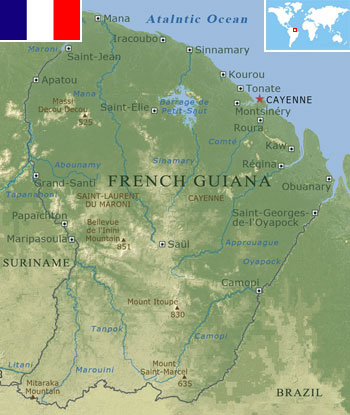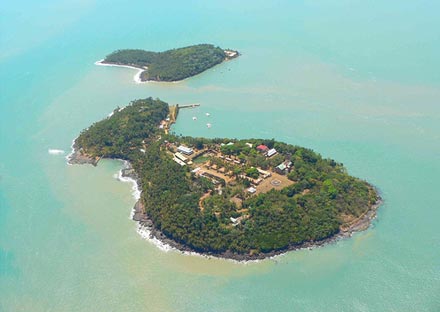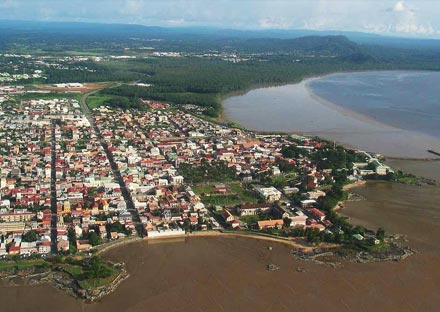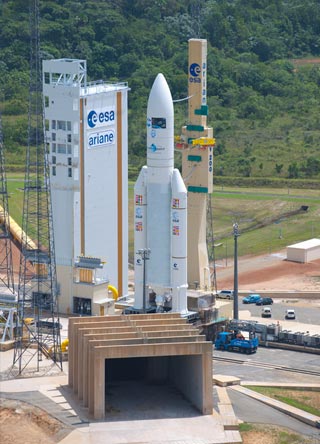French Guiana
Country statistics

Land area: 34,421 sq miles (89,150 sq km)
Total area: 35,135 sq miles (91,000 sq km)
Population (2007 est.): 203,321 (growth rate: 1.8%); birth rate 20.3/1000; infant mortality rate 11.8/1000; life expectancy: 77.5; density per sq miles: 6
Capital City: Cayenne
Monetary unit: Franc
Languages: French
Ethnicity/race: black or mulatto 66%, white 12%, East Indian, Chinese, Amerindian 12%, other 10%
Religions: Roman Catholic
Country introduction

French Guiana is an overseas region of France, located on the north coast of South America. It is bordered by Suriname to the west, Brazil to the south-east and south as well as the Atlantic Ocean to the north.
The coastal strip that extends for 350 km (217 miles) along the Atlantic Ocean is where the majority of the people live. Beyond this strip begins the near-inaccessible great Amazon Rainforest which gradually rises to the modest peaks of the Tumac-Humac mountains along the Brazilian frontier. The Amazon is home to more species of plants and animals than any other terrestrial ecosystem on the planet, perhaps 30% of the world's species are found there. Its biodiversity is astounding: a single bush in the Amazon may have more species of ants than the entire British Isles, while a lone hectare of forest may have more than 480 species of trees. The only way to penetrate the rainforest is through its great rivers and waterways, which form an extremely dense river system.
There are many rivers in French Guiana, including the Waki Camopi, Inini, Ouaqui, Tampoc, Marowiny, Mana, Sinnamary, Comte and Approuague, which flow to the Atlantic Ocean. The Petit-Saut hydroelectric dam in the north of French Guiana forms an artificial lake and provides hydroelectricity.
French Guiana's highest peak is Bellevue de l'Inini in Maripasoula (851 m / 2,792 ft). Other mountains include Mont Machalou (782 m / 2,566 ft), Pic Coudreau (711 m / 2,333 ft) and Mont St. Marcel (634 m / 2,083 ft), Mont Favard (201 m / 660 ft) and Montagne du Mahury (156 m / 512 ft).
Several small islands are found off the coast, which include the Îles du Salut island group famous for being a penal colony from 1852, and the isolated Îles du Connétable bird sanctuary further along the coast towards Brazil.
The culture

French Guiana was discovered by the Spanish in 1496, and the French moved in a century later. Under the 1667 Treaty of Breda, the Dutch, who had also shown an interest in the area, were forced out. The control of French Guiana went through numerous changes over the next 200 years, alternating between France, Britain, the Netherlands and Portugal, until the territory was finally confirmed as French in 1817.
The people of French Guiana live along the coastal regions and most of the population is made up of Mulattos, Creole, and the Haitian community. However, due to the opening of the country during the 1800s, there are smaller groups consisting of refugees and migrants like the Hmong from Laos, and some Chinese people.
As what is obvious from the country's name, the language spoken and understood by most of the population is French. Another language used by some of the people is Taki, which is an aboriginal language. The country's main religion is Catholicism, adopted from the French colonists of the country. Although some of the tribes had their own traditional religion, a majority of the people gradually converted to Catholicism.
Due to the amalgamation of nations, the countries arts are also a mixture of the different art traditions of the tribes. Some pieces done by woodcarving, painting, and weaving have Creole tastes, while others carry the traditional French class. Art strategies are also derivatives of the original techniques of other countries.
Attractions & landmarks

French Guiana is mostly covered with tropical rainforests and a major part of it is taken by the large Guiana Amazonian Park that covers 33,900 sq km (13,090 sq miles) of the region. It was opened as the ninth National Park of France, and since has increased in eco tourism. The park can only be accessed by an airplane or pirogue. The protected land provides ample habitat for big cats like the jaguar and many other mammals to roam free. Some parts of the parks are also inhabited by native tribes, while other areas are kept completely untouched. Inland jungle expeditions can be taken to the gold mining village of Saul. Botanic trails and waterfall hikes are regularly led, and bird watchers and naturalists adventures will enjpy spotting the many toucans, macaws, and other large tropical birds typical of the country.
Îles du Salut, a group of islands about 10 to 15 km (32 to 49 miles) off the coast of French Guiana, were once used as a penal colony from 1852 onwards. Life back then was extremely tough and consisted of such famous convicts as Captain Dreyfus, Seznec, and Papillon. Since 1953 the islands were closed as a prison and gradually became a popular tourist destination. Today, it is an enchanting place to visit, where a walk around the remains of the prisons and a swim in the crystal-clear water can be enjoyed. It is also a favorite place for big-game fishing. The closest town is Kourou from where boats travel to and from the islands, which include Île Royale, Île Saint-Joseph, and Île du Diable (Devil's Island).
The commune of Awala-Yalimapo, located in the extreme north-west of the country close to the border with Suriname, is worth visiting to see around 4,500 to 7,500 giant leatherback turtles nest and lay their eggs on several of the nearby beaches. Hattes Beach is the world's largest nest-building site for these turtles.
Another attraction is the Guiana Space Centre in Cayenne, which is one of the busiest and technically most convenient and advanced space centres in the world. It was built in 1968 and used jointly by France and the European Space Agency.